Undoubtedly, there are bigger whitewater runs in the US than Idaho's Main Salmon River in the Frank Church River of No Return Wilderness Area, but there are none which I have personally run that has been as wild and exciting throughout a week of daily canoeing that comes close to our experiences of July, 2012. A friend whom I have known since I was 6 years old got a cancellation permit just 10 days before our departure date, and I was invited just 4 days before departure from Texas, so it was a hastily planned and outfitted trip for us.
The permit season runs from June 20 through September 7, which is the time when most people flock to the Main Salmon. High water season is from late-May to mid-July, depending upon winter snowpack and recent local rainfall. By the end of July the Main Salmon was at what is locally referred to as "low runnable", which can be very misleading - I am not certain I would even want to be on that river in a loaded solo boat at a higher level. On the third day of our drive up to Idaho we navigated a long, dirt road that ran parallel to and in full view of the river from Salmon to our put-in at Corn Creek where the permit section begins. My friend Randy Stovall had been here the previous year and loved this river, so he was champing at the bit to go again. Randy was rowing his cataraft, his wife Libbi was rowing a 14-foot self-bailing raft and carrying Josh Newton whose father Carey was paddling a Perception Dancer kayak (and carrying NO gear whatsoever!) At the last minute my friends Tom Taylor and Stan Pully rounded out our group of seven, them and me each in our SOAR inflatable canoes.
With every rapid we saw driving to the campground at Corn Creek we grew more excited about what was in store for us. We watched large rafts bucking the huge waves and skirting deep holes, and even from the road above we could tell that we were in for the rides of our lives. Unlike most pool and drop rivers the Main Salmon has almost as much drop as pool, and that is a major change from our Texas topography of shallow gradients and a lot more flatwater than whitewater. We knew that this would be a really super trip even before we hit the water (or before the water hit us!) For the record, the Main Salmon drops about 1,910 feet in 151 miles at an average gradient of about 12 feet per mile, which means the water flows as a steady current.
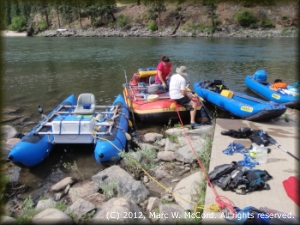 Arriving at Corn Creek Campground, we immediately went to the boat ramp to survey our access, then chose a vacant campsite for the night before our launch. Then, we proceeded back to the boat ramp where we unloaded the cataraft and raft so that Randy and Libbi could start rigging for the next day. It took a long time just to unload the pieces and lay them out so that we could begin assembling the boats. Our SOARs, and Carey's kayak, were much easier to prepare - Carey merely had to put his boat on the river and we had to inflate three tubes on each SOAR before loading them for our trip, and our loading time was about 30 minutes, so we elected to inflate our SOARs in camp and bring them down the morning of our launch.
Arriving at Corn Creek Campground, we immediately went to the boat ramp to survey our access, then chose a vacant campsite for the night before our launch. Then, we proceeded back to the boat ramp where we unloaded the cataraft and raft so that Randy and Libbi could start rigging for the next day. It took a long time just to unload the pieces and lay them out so that we could begin assembling the boats. Our SOARs, and Carey's kayak, were much easier to prepare - Carey merely had to put his boat on the river and we had to inflate three tubes on each SOAR before loading them for our trip, and our loading time was about 30 minutes, so we elected to inflate our SOARs in camp and bring them down the morning of our launch.
On July 22, we finished preparing boats, got our orientation, checkout and campsite assignments from the Ranger, and then were on the water around 1:00 PM, which may seem like a late start, but we only had about 13 miles to go and the water was fast, so we were in great shape. The one truly unexpected encounter was the Idaho summer heat, which was rivaling what we left behind in Texas - we had daytime highs in the low to mid-90's! But, the water was cool, and it frequently splashed all over us keeping us moderated and exhilirated.
It did not take long for the fun to begin. About 1.2 miles into the trip we encountered Killum Rapid, a Class III- run that was pretty much read and run down the middle with no hazards or great technical difficulty, and it was our first opportunity to "cool off" as the waves broke over our boats and onto our bodies. But, immediately, we started to appreciate the immense natural beauty of the Main Salmon, a Class A+ wilderness run of incredible scenery everywhere you looked. For me, THIS is what wilderness whitewater expeditions are all about! This is why I love and prefer wilderness canyon runs over all other paddling that I do. We hardly had the river to ourselves, but probably 90% of the time we were there with just our group of 7, and nobody else within sight or sound - except for the occasional jetboat hauling paddlers or tourists back upriver or downriver. We were surprised by how very courteous the jetboat drivers were - they ALWAYS chopped their engines and NEVER created any wake for us, though it would have only added to the joy of the natural waves we were hitting from the outset.
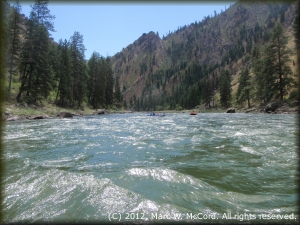 Another 1.2 miles downriver we hit Gunbarrel Rapid (Class III) and ran it after scouting from our boats. It was another read and run down the middle affair, and another chance to beat the Idaho summer heat. We were seeing great campsites all along the river, and all on beautiful, white sand beaches. Also located in this area are First nations pictographs - rock art - left from hundreds of years ago by those who settled here long before Europeans invaded the Western Hemisphere. Unfortunately, we did not stop to look at and photograph them, so we will have to return and do it the next time.
Another 1.2 miles downriver we hit Gunbarrel Rapid (Class III) and ran it after scouting from our boats. It was another read and run down the middle affair, and another chance to beat the Idaho summer heat. We were seeing great campsites all along the river, and all on beautiful, white sand beaches. Also located in this area are First nations pictographs - rock art - left from hundreds of years ago by those who settled here long before Europeans invaded the Western Hemisphere. Unfortunately, we did not stop to look at and photograph them, so we will have to return and do it the next time.
We were constantly running small, unnamed rapids that were fun, but not at all challenging, especially considering our skill levels and the types of boats we were paddling or rowing. It is safe to say that we probably had about 10-12 rapids each day, and many were quite significant, which kept the trip exciting for us all. Of the seven in our group only Randy had run this river, and he did it the first time less than a year earlier at a different water level, so it was like a first descent for us all. Even the smaller rapids were fun, and they gave us opportunities to acclimate to boat handling characteristics before hitting the Class III+ to IV+ runs that would come later.
The second and third days were very much like day one - read and run most rapids and briefly scout a couple just to make sure we knew where we were going. Each night, we had excellent campsites and gorgeous scenery to underscore a truly spectacular river trip. We had three major rapids near the end of day three - Bailey (Class III+), Five Mile (III) and Split Rock (III) - that were a lot of fun and sent Tom swimming a couple of times, but posed no serious problems. Besides, Tom was overheating and needed to cool off anyway!
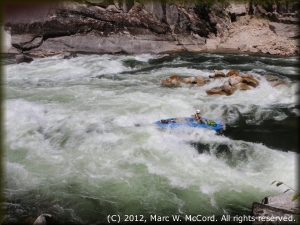 The real fun started on day four shortly after launching from our Lower Yellow Pine campsite, and I mean REALLY shortly! We intended to scout Big Mallard Rapid, probably the second biggest drop on the entire river, but there were so many boats already lined up along the banks that we decided to read and run, putting on a show for those already lining the banks for a quarter mile. I think that I was the last to go. Tom had already been flipped, and most of the others took the sneak route off the right side of the tongue into the eddy on river right. I decided that they were working much too hard extricating themselves from the eddy, and so I rode the far right edge of the tongue just inside the eddy line. All was fine at first, and then my boat got turned sideways. Knowing that I did NOT want to run that rapid sideways I attempted to turn back forward, but the current and the weight in my boat prevented it, so I quickly turned backward and was running the rapid perfectly - until about two thirds of the way through it when I suddenly shot down to the bottom of a huge hole and got slammed on my right should by a huge wave that knocked me out of and under my boat. (The photo above is me running Bailey Rapid (Class III) the previous day - unfortunately, nobody got any photos of us running Big Mallard.
The real fun started on day four shortly after launching from our Lower Yellow Pine campsite, and I mean REALLY shortly! We intended to scout Big Mallard Rapid, probably the second biggest drop on the entire river, but there were so many boats already lined up along the banks that we decided to read and run, putting on a show for those already lining the banks for a quarter mile. I think that I was the last to go. Tom had already been flipped, and most of the others took the sneak route off the right side of the tongue into the eddy on river right. I decided that they were working much too hard extricating themselves from the eddy, and so I rode the far right edge of the tongue just inside the eddy line. All was fine at first, and then my boat got turned sideways. Knowing that I did NOT want to run that rapid sideways I attempted to turn back forward, but the current and the weight in my boat prevented it, so I quickly turned backward and was running the rapid perfectly - until about two thirds of the way through it when I suddenly shot down to the bottom of a huge hole and got slammed on my right should by a huge wave that knocked me out of and under my boat. (The photo above is me running Bailey Rapid (Class III) the previous day - unfortunately, nobody got any photos of us running Big Mallard.
I never had time to grab a breath of air because I did not see that wave coming for me, so getting to the surface quickly was my only concern. On four successive attempts to surface my head hit the bottom of my boat. Finally, I opened my eyes, saw the position of my boat above me, and then swam a few feet out to the side breaking the surface just as I was about to take an involuntary breath. Two or three more second underwater would have been perilous for me, and would possibly have ended my river running days right there. But, I made it losing my Tilley hat in the process (it was recovered a short distance downstream by a member of our group), but I hung on to my paddle for dear life (it is much too expensive to lose.) I was helpless to do anything because I was exhausted and gasping for air. I managed to turn backward so the waves would break over my head and not hit my open mouth where I was sucking in as much air as quickly as I possibly could do.
I was on the surface trying to get into a passive swim position because I had no strength to swim out of the fast current, so I just rode the run-out through the rest of that big duck until Stan got to me, grabbed my PFD by the shoulder straps and hauled me to the river left bank where I took about fifteen minutes getting my breath under control and my strength back. The truth is that trying to swim out of the current is an exercise in futility anyway, so I naturally did the only thing that would be recommended even if I had energy to swim. I would have run the rapid again if I could have gotten my friends to carry me and my boat back up to the top, but I could get no takers, so we loaded up and headed on downstream. My boat, by the way, ran the rest of the rapid upright without me and then eddied out near the end of the rapid. Gotta love that SOAR S16! It's the best boat I ever had for running big water.
We got downriver, pulled over for lunch, and finished eating without seeing another boat come through. Apparently, what they saw happen to us got their attention and they must have scouted the run for a much longer time. I imagine some of them found ways to line or portage Big Mallard. I would bet that they all did everything possible to avoid running that rapid backward! The next time I run it I will do likewise.
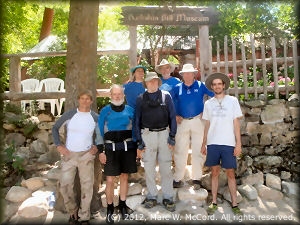 The next two days were a lot more fun with numerous rapids that demanded boat control and good decision-making skills. We encountered no problems, though we did get very wet often, and that was great considering the daily temperature, especially in mid-afternoon. Since we only had a short distance to go each day we made no effort to be on the river at the crack of dawn. Our launches were a lot closer to the crack of noon, and we still made camp well before dark each day. On day 5 we stopped at Buckskin Bill's, aka Fivemile Bar, where a store and museum offers cold drinks, ice, snacks and sundry other goodies including ice cream, which tastes pretty good after four and a half days on the river, and we availed ourselves of at least one ice cream each (some had two) and a few soft drinks, as well as restocking with ice, which was sold in one gallon milk jugs. It was just enough to get us through the end of our trip, preserving those few items that needed to be kept cold enough not to spoil.
The next two days were a lot more fun with numerous rapids that demanded boat control and good decision-making skills. We encountered no problems, though we did get very wet often, and that was great considering the daily temperature, especially in mid-afternoon. Since we only had a short distance to go each day we made no effort to be on the river at the crack of dawn. Our launches were a lot closer to the crack of noon, and we still made camp well before dark each day. On day 5 we stopped at Buckskin Bill's, aka Fivemile Bar, where a store and museum offers cold drinks, ice, snacks and sundry other goodies including ice cream, which tastes pretty good after four and a half days on the river, and we availed ourselves of at least one ice cream each (some had two) and a few soft drinks, as well as restocking with ice, which was sold in one gallon milk jugs. It was just enough to get us through the end of our trip, preserving those few items that needed to be kept cold enough not to spoil.
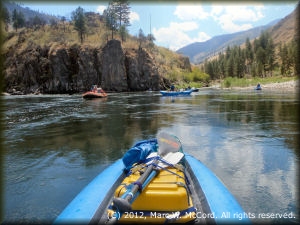 Every day the scenery just seemed to get better, and I spent a lot of time shooting photos, recording nearly 350 in all (it would have been more, but the numerous rapids limited the time spent taking photos.) On the seventh and last day we busted through a couple of pretty good Class III to III+ rapids (Dried Meat and Chittam), and it looked like smooth sailing to the take-out at Carey Creek. About two miles from the end of the trip we ran into a mean and gnarly Vinegar Rapid just below the confluence of Vinegar Creek, and the Main Salmon saved the best for last. We scouted from the right bank, and it was apparent that this was going to be a tough run. Starting just left of center is a tongue of swiftwater with a giant hole on the top left side and an even bigger one in the center of the river on the left side of the left-to-right flowing tongue. Again, most in our group chose the sneak route to the right where a strong eddy awaited. Being brave after having survived everything else the river threw at me, I chose to run the right edge of the tongue avoiding the two giant holes with their monster waves - or, at least that was the plan.
Every day the scenery just seemed to get better, and I spent a lot of time shooting photos, recording nearly 350 in all (it would have been more, but the numerous rapids limited the time spent taking photos.) On the seventh and last day we busted through a couple of pretty good Class III to III+ rapids (Dried Meat and Chittam), and it looked like smooth sailing to the take-out at Carey Creek. About two miles from the end of the trip we ran into a mean and gnarly Vinegar Rapid just below the confluence of Vinegar Creek, and the Main Salmon saved the best for last. We scouted from the right bank, and it was apparent that this was going to be a tough run. Starting just left of center is a tongue of swiftwater with a giant hole on the top left side and an even bigger one in the center of the river on the left side of the left-to-right flowing tongue. Again, most in our group chose the sneak route to the right where a strong eddy awaited. Being brave after having survived everything else the river threw at me, I chose to run the right edge of the tongue avoiding the two giant holes with their monster waves - or, at least that was the plan.
My entry was perfect, and I caught the right edge and rode it at what my GPS recorded as 13.9 mph. It felt like I was in a river rocket. Near the hole in the center of the river a cross current pushed me left and down to the bottom of that very deep hole that swallowed my boat. Then, a wave I estimate at about 14 feet hit the left bow and flipped me like paper. This time I saw it coming and got a full breath of air. I hit the water about 8 feet to the side of my flipped boat, assumed a passive swim position (paddle still in hand like I did at Big Mallard) and rode through the run-out waves until Randy arrived on his cataraft, which I grabbed on the bar right behind his seat and held on while he rowed me to the bank. WHAT A RIDE! That Class IV to IV+ monster power washed me right before the take-out.
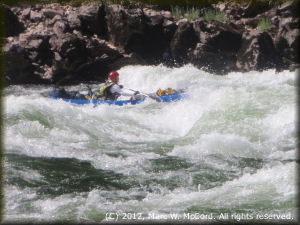 The hardest part of that run was flipping my SOAR S16 with its tightly strapped load back upright so I could paddle the last 1.5 miles to the take-out. It took Randy, Stan and me several tries to get the job done, but we managed on about the fourth attempt. Hell, I should have just climbed up on the bottom of the boat and paddled it upside-down to the take-out at Carey Creek. I know the sun completely dried me before arriving at the end of the 84 mile, 7-day trip. The photo at the right is Tom running Chittam Rapid (Class III) just above Vinegar Creek.
The hardest part of that run was flipping my SOAR S16 with its tightly strapped load back upright so I could paddle the last 1.5 miles to the take-out. It took Randy, Stan and me several tries to get the job done, but we managed on about the fourth attempt. Hell, I should have just climbed up on the bottom of the boat and paddled it upside-down to the take-out at Carey Creek. I know the sun completely dried me before arriving at the end of the 84 mile, 7-day trip. The photo at the right is Tom running Chittam Rapid (Class III) just above Vinegar Creek.
It took a long time, probably at least three hours, to break down and pack away our boats and gear for the ride back home. Our SOARs and Carey's kayak went pretty fast, but we had to completely disassemble the cat and the raft. During the process we realized that somebody had dragged a trailer down the right side of Randy's truck and left a nasty crease from the right front door to the right rear quarter panel, and of course they did not bother to leave a note. Oh well, there was nothing we could do about it now.
We loaded up, got in our cars and headed into Riggins where we ate dinner before starting home. Carey and Josh were light and fast. Randy, Libbi and Stan planned to take four days to get back home. Tom and I made it over 1,800 miles in less than two days, stopping overnight at Lanthrop State Park just outside Walsenburg, Colorado before embarking on the final leg of one of the very best trips we have ever done. All the way home we talked about what a great trip it was and started making plans to return in 2013, if we can get a permit. If not, then we might do a late season trip after the permit period ends in early September provided there is adequate water, and this year there was. The Main Salmon was definitely a river to which we want to return, and possibly add the Middle Fork to the trip if we can get super lucky in arranging permits back-to-back for a 13-18 day trip stopping at Carey Creek or proceeding on down to Riggins.
It may be called the Frank Church River of No Return, but that will NOT apply to us! We will be back for another crack at the finest whitewater trip I have ever taken, and the next time I intend to stay in my boat on ALL the rapids. The Main Salmon may have other ideas and plans for me! As long as I live over it I do not mind getting an unexpected bath, especially if that is the price of admission for such a spectacular river and a great trip with special friends.


